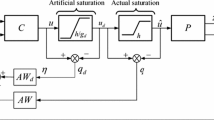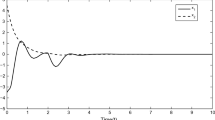Abstract
This paper considers anti-windup design for linear systems subject to actuator saturation. Three anti-windup gains are designed for activations immediately at the occurrence actuator saturation, after the saturation has reached a certain level and in anticipation of the occurrence of saturation, respectively. The design is based on the minimization of L 2 gain from the disturbance to the controlled output of the resulting closed-loop system. Traditional anti-windup scheme involves a single anti-windup loop for immediate activation. A recent innovation is to design a single anti-windup loop for delayed or anticipatory activation, as well as to design two anti-windup gains, one for immediate activation and one for delayed activation. Our design of three anti-windup gains for three different activations is shown through simulation to lead to significant further performance improvement over the previous activation schemes.
Similar content being viewed by others
References
Bernstein D S, Michel A N. A Chronological bibliography on saturating actuators. Int J Robust Nonlinear Control, 1995, 5: 375–380
Hu T, Lin Z. Control Systems with Actuator Saturation: Analysis and Design. Cambridge: Birkhauser Boston Inc, 2001
Jin Y Q, Liu X D, Qiu W, et al. Time-varying sliding mode control for a class of uncertain MIMO nonlinear system subject to control input constraint. Sci China Inf Sci, 2010, 53: 89–100
Stevens B L, Lewis F L. Aircraft Control and Simulation. 2nd ed. New York: Wiley-Interscience, 2003
Edwards C, Postlethwaite I. Anti-windup and bumpless transfer schemes. Automatica, 1998, 34: 199–210
Galeani S, Tarbouriech S, Turner M C, et al. A tutorial on modern anti-windup design. In: Proc 10th Euro Contr Conf, Budapest, 2009. 418–440
Tarbouriech S, Turner M. Anti-windup design: an overview of some recent advances and open problems. IET Control Theory Appl, 2009, 3: 1–19
Astrom K J, Rundqwist L. Integrator windup and how to avoid it. In: Proc Amer Contr Conf, Pittsburgh, 1989. 1693–1698
Glattfelder A G, Schaufelberger W. Stability analysis of single-loop control systems with saturation and antireset windup circuit. IEEE Trans Autom Control, 1983, 28: 1074–1081
Gomes J M, da Silva Jr, Tarbouriech S. Antiwindup design with guaranteed regions of stability: an LMI-based approach. IEEE Trans Autom Control, 2005, 50: 106–111
Grimm G, Hatfield I, Teel A T, et al. Antiwindup for stable linear systems with input saturation: an LMI-based synthesis. IEEE Trans Autom Control, 2003, 48: 1509–1525
Hu T, Teel A R, Zaccarian L. Reginoal anti-windup compensation for linear systems with input saturation. In: Proc Amer Contr Conf, Chicago, 2005. 3397–3402
Kose I E, Jabbari F. Scheduled controllers for linear systems with bounded actuators. Automatica, 2003, 39: 1377–1387
Mulder E F, Kothare M V, Morari M. Multivariable anti-windup controller synthesis using linear matrix inequalities. Automatica, 2001, 37: 1407–1416
Teel A R, Kapoor N. The L 2 anti-windup problem: its definition and solution. In: Proc 10th Euro Contr Conf Brussels, 1997. 120–128
Turner M C, Postlethwaite I. A new perspective on static and low-order anti-windup synthesis. Int J Control, 2004, 77: 27–44
Wu F, Grigoriadis K M, Packard A. Anti-windup controller design using linear paramter-varying control methods. Int J Control, 2000, 73: 1104–1114
Sajjadi-Kia S, Jabbari F. Modified anti-windup compensators for stable plants. IEEE Trans Autom Control, 2009, 54: 1934–1939
Sajjadi-Kia S, Jabbari F. Modified anti-windup compensators for stable plants: dynamic anti-windup case. In: 48th IEEE Conference on Decision and Control and 28th Chinese Control Conference, Shanghai, 2009. 2795–2800
Sajjadi-Kia S, Jabbari F. Scheduling in anti-windup controllers: output feedback case. In: 46th IEEE Conf Dec Contr, New Orleans, 2007. 408–413
Wu X, Lin Z. Anti-windup in anticipation of actuator saturation. In: 49th IEEE Conference on Decision and Control, Atlanta, 2010. 5245–5250
Wu X, Lin Z. Dynamic anti-windup design in anticipation of actuator saturation. In: 2011 American Control Conference, San Francisco, 2011. 4446–4451
Wu X, Lin Z. On immediate, delayed and anticipatory activation of anti-windup mechanism, static anti-windup case. IEEE Trans Autom Control, 2012, 57: 771–777
Sajjadi-Kia S, Jabbari F. Scheduled static anti-windup augmentation synthesis for open-loop stable plants. In: Proc American Contr Conf, Baltimore, 2010. 6751–6756
Author information
Authors and Affiliations
Corresponding author
Rights and permissions
About this article
Cite this article
Wu, X., Lin, Z. Design of multiple anti-windup loops for multiple activations. Sci. China Inf. Sci. 55, 1925–1934 (2012). https://doi.org/10.1007/s11432-012-4645-0
Received:
Accepted:
Published:
Issue Date:
DOI: https://doi.org/10.1007/s11432-012-4645-0




